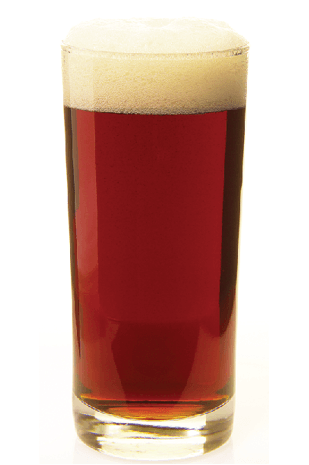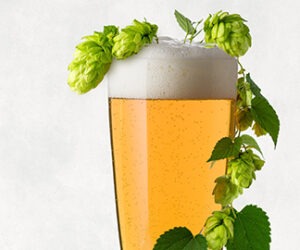Düsseldorf Altbier: Style Profile
While driving through Ge
It turned out to be one of the greatest beer experiences I have ever had. We wandered the Altstadt, stopping in to sample beers from pubs that have been brewing the same beer for 800 years. The sense of history and the quality of the beer makes this an amazing destination for any beer geek. The friendliness of the locals makes it a wonderful stop for any tourist. All of these pubs brew and serve just one kind of beer served in one size glass. They bring the beer up in wooden casks from the cellar and roll them across the pub floor using their feet. They serve the beer by gravity, tapping the keg with a simple faucet. You simply sit down and ask for “ein Bier bitte” (A beer please).
Some travelers like to take pictures of buildings and statues. I like to take photos of the beers I drink. At Brauerei Zum Schlüssel I took a picture of my beer and a very large fellow at the end of the bar, speaking German, said in a very gruff voice, “Hey Cowboy, are you taking a picture of me?” I fumbled for the German words to explain that I was only taking a picture of the beer, when the locals chimed in that I just liked the beer. Of course, the big guy was just kidding around and we all had a good laugh. That is one of my fondest beer memories ever, because of my family and the wonderful people of Düsseldorf.
Düsseldorf altbier is a well-balanced, lagered, German ale — it is often referred to by Germans as “obergäriges Lagerbier” (top-fermented lager beer) — with a rich and complex malt character. The flavor and aroma often have rich bready and caramel notes. A firm hop bitterness balances the malt and good examples range from balanced to a little bitter. Hop character is never stronger than moderate. This is a beer more about malt character and balance, and it is never a hop-forward beer. In all cases, malt character is the main focus of this style. Fermentation is very clean for an ale, almost lager-like, with slight fruity notes in some examples, and while it should have a medium body, the finish should still be drier than sweeter.
Unfortunately, many people have a flawed understanding of what Düsseldorf altbier should taste like. I recall an American brewery that would always receive gold medals for its altbier, yet it was insanely bitter. The malt character was there, but the bittering was through the roof. Yes, altbier should have a certain level of bittering, but the result is almost always more of a balanced character than it is a bitter-forward one. In fact, the more bitter-forward examples are more of an exception, not the rule. Of course, most judges have never tasted a fresh, classic example, so if winning at competition is your goal, then leaning toward the bitter side is probably to your advantage.
An altbier recipe can be simple or complex. The key to brewing altbier is using the proper yeast and fermenting cool, but still getting enough attenuation to avoid too much residual sweetness. If you want to make something like what you find at Zum Uerige, some Pilsner, Munich, and a little crystal malt is all it takes. If you want something darker, richer, and more complex such as you would find at Zum Schlüssel, you can add in a bit more specialty malt. Keep in mind that all German beers are easy-drinking and even though you might want rich malt character, you want to keep the beer from being too full and rich. The best way to achieve that great German malt character is with high quality, full-flavored base malts and excellent fermentation practices. Continental Pilsner and Munich malts, plus some crystal malt is a good base. The bulk of the grist should be Pilsner malt, anywhere from 65 to 90%. A portion of the grist should always be Munich malt. Anywhere from 10 to 30% works well, depending on the color and character of the Munich malt. One of my favorite tricks in developing a diverse malt character is splitting the Munich malt additions between a lighter Munich (8 °L) and a darker version (20 °L). I generally keep it around 2⁄3 lighter and 1⁄3 darker. Caramel malt adds a little malty sweetness, which helps balance the firm bittering. You can experiment with different Lovibond caramel malt and percentages, but approximately 5% of a mid-color (40 to 80 °L) caramel is plenty. If you need a little more color, a small portion of a huskless dark malt such as Weyermann Carafa® Special or Briess Blackprinz® malt adds color without adding roasty notes. You do not want roast character in your altbier.
Extract brewers will need to use a Munich malt extract or do a partial mash with Munich malt. Most Munich malt extract is a blend of Munich and Pilsner (or other pale malts) in different percentages. I would try to get an extract made with as much Munich malt as possible for this style, but always let flavor and freshness be your guide. That said, most Munich extract blends are close enough for a decent altbier.
I like to avoid any work that I do not feel really improves a beer, so I prefer a single-infusion mash. Perhaps, historically, a brewer would use a decoction mash when brewing most German-style beers, but I find that high quality continental malts, a single-infusion mash, and excellent fermentation practices will produce beer every bit as good as the best commercial examples. It is far more important to invest time and effort in fermentation, sanitation, and post-fermentation handling than on decoction. If you have ensured that all of those other aspects of your process are flawless, then decoction might be something of interest. For a single-infusion mash, target a mash temperature range of 148-154 °F (64-68 °C). Use higher mash temperatures for lower gravity beers and beers with fewer specialty grains, and lower mash temperatures for higher gravity beers and beers with larger amounts of specialty grains.
Hop character should be minimal to moderate in altbier, and most examples have some subtle background noble hop character that comes across as peppery, floral or perfume-like. Less frequently, you will find an example with some hop aromatics as well. In general, a moderate flavor hop addition during the last 15 minutes of the boil of ½ to 1 oz. (14-28 g) of noble hops for a 5-gallon (19-L) batch should get you in the ballpark. Keep it subtle and use only floral or spicy hops. Spalt hops are traditional in altbier, but I prefer German-grown Tettnang hops. Other German-grown hops, such as Hallertau, Perle or Tradition work well also. These hops, when grown outside of Germany, can still work well but you should check with your supplier first if you are not sure how closely they match the German-grown varieties. If you cannot get any of those hops, try to select hops with that same flowery or spicy noble hop character. You do not want to use anything fruity or citrusy. Some decent substitutions are Liberty and Mt. Hood. You can also try Crystal, Ultra, and Vanguard. The big picture is that you want restrained hop character and a balancing bitterness that both complement and integrate with the malt. The balance of bitteringversus malt sweetness should be even or slightly on the bitter side. The bitterness to starting gravity ratio (IBU divided by the decimal portion of the specific gravity) ranges from 0.6 to 1.0. I like to target around 0.9 forthe brew day, because during the long lagering period after fermen-tation some of the bittering will settle out, leaving the beer less bitter than initially brewed.
I have tried fermenting Düsseldorf altbier with lager yeast and clean American ale yeasts and the results have been very good. However, if what you want is great altbier (and I am sure that is what you want), then your best choice is most likely White Labs WLP036 Düsseldorf Alt or Wyeast 1007 German Ale. I pitch 50% more yeast for altbier fermentation than I do for most ales. I like to start fermentation cool, in the low 60s Fahrenheit (~16-17 °C) and then let the temperature ramp up toward the end of fermentation. This only works well if you pitch enough active, healthy yeast. In fact, if you read the WLP036 description on the White Labs website, it will warn you away from fermenting too cold with this yeast. Yeast that is stressed produces more sulfur, and slow, sluggish fermentations do leave more sulfur in solution as well. The solution to this is pitching enough healthy yeast and to ramp up the temperature as soon as there is any sign that the fermen-tation might be slowing down. Vig-orous fermentation drives off more of the volatile compounds, attenuates better, and results in a cleaner tasting final product.
For altbier, I like to chill the wort down to 60 °F (16 °C), oxygenate, and then pitch my yeast. I let the beer slowly warm over the first 36 hours to 63-65 °F (17-18 °C) and then I hold this temperature for the remainder of fermentation. If fermentation seems sluggish at all after the first 24 hours, I am not afraid to raise the temperature a couple degrees more. Once the growth phase of fermentation is complete, it is important to have enough activity to blow off aromatic sulfurs and other unpleasant compounds. Vigorous yeast activity at the end
of fermentation also improves reduction of compounds such as diacetyl. Keep in mind that starting fermentation colder only works well if you are pitching enough clean, healthy yeast at the start. If not, you will need to start warmer (perhaps 65 °F/18 °C) to encourage more yeast growth. Even if you start fermentation warmer, you can still raise the temperature toward the latter part of fermentation.
Since diacetyl reduction is slower at colder temperatures, a cold fermented altbier may require a diacetyl rest. To perform a diacetyl rest, simply raise the temperature into the 65-68 °F (18-20 °C) range for a two-day period near the end of the fermentation. While you can do a diacetyl rest after the fermentation reaches terminal gravity, a good time for a diacetyl rest is when fermentation is 2-5 specific gravity points (0.5-1 °P) prior to reaching terminal gravity. Brewers ask how they should know when fermentation has reached that stage. My advice is to raise your fermentation temperature for a diacetyl rest as soon as you see fermentation activity significantly slowing. It will not hurt the beer and it should help the yeast reach complete attenuation as well.
It seems that every beer improves with some period of cold conditioning and in this style it should be considered mandatory. Traditional lager conditioning utilizes a slow temperature reduction before fermentation reaches terminal gravity. The purpose of the slow cooling rate is to avoid sending the yeast into dormancy. After a few days, the beer reaches a temperature close to 40 °F (4 °C) and the brewer transfers the beer into lagering tanks. If you want to use this technique, you will need precise temperature control so that fermentation slowly continues and the yeast remains active. Rapidly chilling the beer near the end of fermentation can cause yeast to excrete a greater amount of ester compounds instead of retaining them.
I prefer to wait until fermentation is complete, including any steps such as a diacetyl rest, before lowering the beer temperature. The yeast is far more active and able to reduce fermentation byproducts at higher temperatures. Once I am certain the yeast have completed every job needed, I use a period of cold storage near freezing. This time in storage allows very fine particulates to settle out and the beer flavors to mature.
Related Links
For another BYO writer’s take on Düsseldorf altbier, check out this story from our archives published in 2004 at: www.byo.com/story582
DÜSSELDORF ALTBIER
by the numbers
OG: 1.046–1.054 (11.4–13.3 °P)
FG: 1.010–1.015 (2.6–3.8 °P)
SRM: 11–17
IBU: 35–50
ABV: 4.5–5.2%
Cowboy Alt
(5 gallons/19 L, all-grain)
OG = 1.050 FG = 1.013
IBU = 45 SRM= 15 ABV= 4.9%
I currently use Best Malz Pilsen and Munich. The aromatic malt is a product of Briess Malt. The CaraMunich® and Carafa® Special are products of Weyermann. Feel free to substitute any high-quality malt of the same type and color from a different supplier. My hops are in pellet form and come from Hop Union, Willamette Valley, or Hopsteiner.
Ingredients
7.3 lbs. (3.3 kg) continental Pilsner malt (2 °L)
1.8 lbs. (0.8 kg) Munich malt (8 °L)
14.1 oz. (0.4 kg) Briess Aromatic® (Munich) malt (20 °L)
7.1 oz. (0.2 kg) Weyermann Caramunich® III (57 °L)
2.6 oz. (75 g) Weyermann Carafa® Special II (430 °L)
8.75 AAU Magnum hops (60 min.) (0.67 oz./19 g at 13% alpha acids
1.7 AAU Tettnanger hops (15 min.) (0.42 oz./12 g at 4% alpha acids
1 tsp Irish moss
White Labs WLP036 (Düsseldorf Alt) or Wyeast 1007 (German Ale)
3/4 cup corn sugar (if priming)
Step by Step
Mill the grains and dough-in targeting a mash of around 1.5 quarts of water (1.4 L) to 1 pound (0.45 kg) of grain (a liquor-to-grist ratio of about 3:1 by weight) and a temperature of 149 °F (65 °C). Hold the mash at 149 °F (65 °C) until enzymatic conversion is complete. Infuse the mash with near- boiling water while stirring or with a recirculating mash system raise the temperature to mash out at 168 °F (76 °C). Sparge slowly with 170 °F (77 °C) water, collecting wort until the pre-boil kettle volume is around 6.5 gallons (25 L) and the gravity is 1.039.
The total wort boil time is 90 minutes, which helps reduce the S-methyl methionine (SMM) present in the lightly kilned Pilsner malt and results in less dimethyl sulfide (DMS) in the finished beer. Add the first hop addition with 60 minutes remaining in the boil. Add Irish moss or other kettle finings and the second hop addition with 15 minutes left in the boil. Chill the wort to 60 °F (16 °C) and aerate thoroughly and pitch the yeast. I pitch 50% more yeast for altbier fermentation than I do for most ales. The proper pitch rate is around 230 billion cells, which is approximately two packages of liquid yeast or one package of liquid yeast in a 2.7 liter starter.
Let the beer slowly warm over the first 36 hours to 63-65 °F (17-18 °C) and then hold at this temperature for the remainder of fermentation. If fermentation seems sluggish at all after the first 24 hours, I am not afraid to raise the temperature a couple degrees more. With healthy yeast, fermentation should be complete around 7 to 10 days, but do not rush it. Cold fermented beers take longer to finish than ales or lagers fermented at warmer temperatures. If desired, perform a diacetyl rest during the last few days of active fermentation. Rack to a keg and force carbonate or rack to a bottling bucket, add priming sugar, and bottle. Target a carbonation level of 2 to 2.5 volumes. A month or more of cold conditioning at near-freezing temperatures will improve the beer.
Cowboy Alt
(5 gallons/19 L, extract with grains)
OG = 1.050 FG = 1.013
IBU = 45 SRM= 16 ABV= 4.9%
I have used a number of Munich blend extracts. Most should do an admirable job of brewing an altbier. Always choose the freshest extract that fits the beer style. If you cannot get fresh liquid malt extract, use an appropriate amount of dry extract instead. CaraMunich® and Carafa® Special are products of Weyermann. Feel free to substitute any high-quality malt
of the same type and color from a different supplier.
Ingredients
6.8 lbs. (3.1 kg) Munich blend liquid malt extract (LME) (6 °L)
7.1 oz. (0.2 kg) Weyermann Caramunich® III (57 °L)
2.6 oz. (75 g) Weyermann Carafa® Special II (430 °L)
8.75 AAU Magnum hops (60 min.) (0.67 oz./19 g at 13% alpha acids
1.68 AAU Tettnanger hops (15 min.) (0.42 oz./12 g at 4% alpha acids
1 tsp. Irish moss
White Labs WLP036 (Düsseldorf Alt) or Wyeast 1007 (German Ale)
3/4 cup corn sugar (if priming)
Step by Step
Add enough water to the malt extract to make a pre-boil volume of 5.9 gallons (22.3 liters) and a gravity of 1.043. Stir thoroughly to help dissolve the extract and bring to a boil.
Once the wort is boiling, add the bittering hops. The total wort boil time is one hour after adding the first hops. Add Irish moss or other kettle finings and the second hop addition with 15 minutes left in the boil. Chill the wort to 60 °F (16 °C) and aerate thoroughly. Then pitch the yeast. I pitch 50% more yeast for altbier fermentation than I do for most ales. The proper pitch rate is around 230 billion cells, which is approximately two packages of liquid yeast or one package of liquid yeast in a 2.7 liter starter.
Let the beer slowly warm over the first 36 hours to 63-65 °F (17-18 °C) and then hold at this temperature for the remainder of fermentation. If fermentation seems sluggish at all after the first 24 hours, I am not afraid to raise the temperature a couple degrees more. With healthy yeast, fermentation should be complete around 7 to 10 days, but do not rush it. If desired, perform a diacetyl rest during the last few days of active fermentation. Rack to a keg and force carbonate or rack to a bottling bucket, add priming sugar, and bottle. Target a carbonation level of 2 to 2.5 volumes. A month or more of cold conditioning at near-freezing temperatures will improve the beer.



